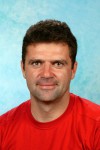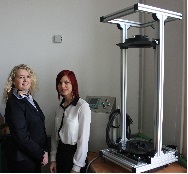2012 /2013
Drehtisch zum Umlaufschweißen
Jahrgang
Projektpartner
HTL Neufelden
Maturanten

Neumüller Laura
5AAT

Roth Liesa
5AAT
Betreuer

Felhofer Hubert

Leitner Gerald
Wenn zwei Rohre miteinander verschweißt werden sollen benötigt man eine Umlaufschweißnaht. Dieses Verfahren ist mit einigen Schwierigkeiten verbunden. Man muss den Schweißvorgang mehrmals unterbrechen um das Bauteil weiter zu rücken oder man kommt zum Beispiel in Konflikt mit dem Masseanschluss. Zur Lösung dieses Problems werden die beiden zu verbindenden Bauteile eingespannt und mit einem Motor gleichmäßig gedreht. Die zu verschweißenden Bauteile können entweder rechteckig oder rund sein. Der Schweißstrom wird über die Grundplatte eingeleitet. Außerdem sollen sämtliche drehbaren Bauteile abgedeckt werden, damit sich niemand verletzen kann.
Das erste Konzept wäre ein Rollwagen gewesen, auf welchen die beiden Spannvorrichtungen befestigt werden sollten. Er wäre höhenverstellbar und zum Kippen geeignet gewesen.
Dieses Konzept wurde auf Wunsch von Herrn Leitner verworfen und ein neues entwickelt.
Das endgültige Konzept setzt sich aus einem Rahmen und den beiden Spannvorrichtungen zusammen. Die obere Spannvorrichtung ist hierbei höhenverstellbar. Für beide gibt es jeweils zwei verschiedene Konzepte zur Verwirklichung der Anforderungen. Außerdem ist der obere Teil des Rahmens abnehmbar. Der Rahmen besteht aus Bosch-Alu-Profilen. Die untere Spannvorrichtung ist auf einer Hohlwelle befestigt welche selbst in einem Rillenkugellager montiert ist. Diese Hohlwelle dient als Zentrierung für Zahnrad und Lochplatte, auf der das Bauteil festgespannt wird. Der Schweißstrom wird mit Schleifkohlen auf das Zahnrad übertragen. Das Zahnrad wird von einem Motor über ein kleineres Ritzel angetrieben.
Die Elektronik zur Drehzahlregelung befindet sich in einem abnehmbaren Schaltkasten. Die Drehzahl kann entweder mit einem Drehpotentiometer und einem Fußpoti geregelt werden oder durch Eingabe von Durchmesser und Vorschub in das Display errechnet werden. Die Vorrichtung kann entweder in- oder gegen den Uhrzeigersinn angetrieben werden. Der Notausschalter ist am Rahmen befestigt um ihn im Notfall schnell erreichen zu können.
Die gesamte Konstruktion kann sowohl auf den in der Schweißerei vorhandenen Lochtisch und auf den Brennschneidetisch moniert werden.
Two components should be connected with a circular weldseam. In this process some difficulties appear. During the welding process you have to turn the assembly to avoid problems for example with the connection to the ground. To solve these problems both components will be clamped and an engine will turn them steadily. The components can be square or round. The welding current will be discharged through the base plate. In addition all the turning parts have to be covert so no one will be hurt. The first concept should have been a creeper on which both fastening devices should be fixed. It would be adjustable in height and suitable for tipping. This concept was dropped due to Mr. Leitners wish and a new one was developed. The final concept is made up of a frame and the two fastening devices. The upper chuck is adjustable in height. For each device there are two concepts to satisfy the requirements. In addition the upper part of the frame is demountable. The frame is made out of Bosch-Aluminium-shapes. The lower fastening device is fixed on a hollow shaft which is assembled into a deep groove ball bearing. This hollow shaft serves as centring for the gear-wheel and the hole perforation plate. The construction components are fixed on this plate. The welding current is transferred over a sliding contact to the gear-wheel. An engine is actuating the gear-wheel through a bevel. The electronic system for the speed regulation is located in a demountable electrical cabinet. The speed can be regulated through a rotary potentiometer and a foot potentiometer. Or it can be calculated with the data of the diameter and the heading into the display. The machine can rotate clockwise and anti-clockwise. The emergency stop switch is located on the frame so it can be reached easily during an emergency. The whole assembly can be mounted on the hole table and the flame cutting table which are both located in the welding shop.


